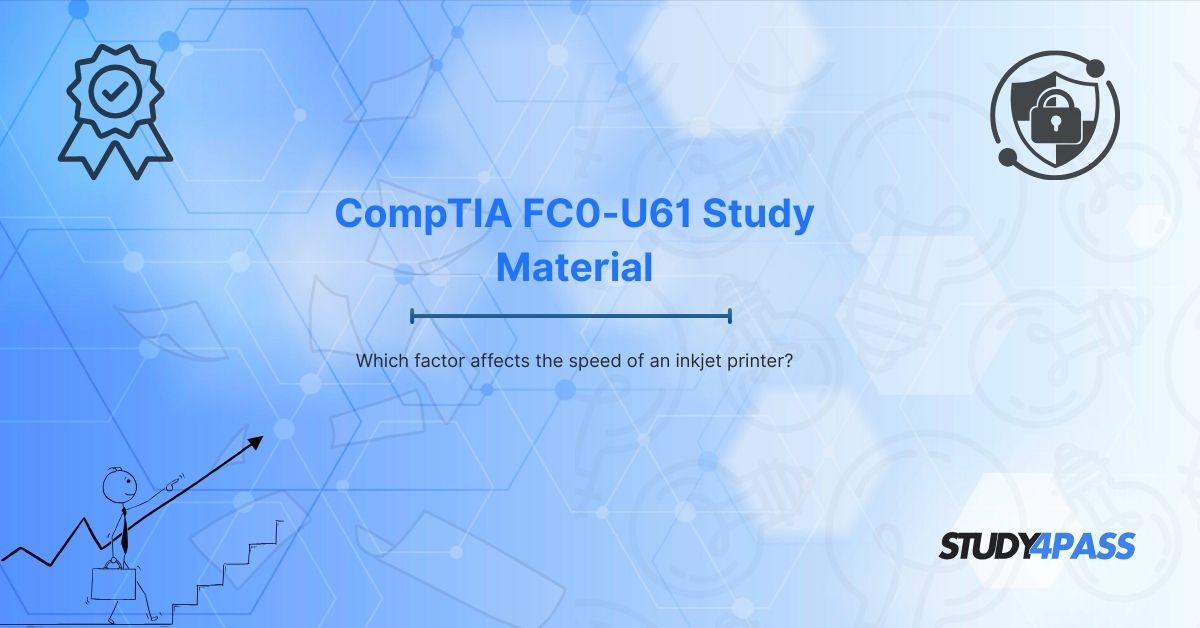Introduction
Inkjet printers are widely used in homes and offices due to their affordability, high-quality output, and versatility. However, one common concern among users is printing speed. Several factors influence how fast an inkjet printer can produce documents or images. Understanding these factors can help users optimize their printing processes and choose the right printer for their needs.
This article explores the key factors affecting the speed of an inkjet printer, aligning with the CompTIA IT Fundamentals (FC0-U61) exam objectives. Additionally, we recommend Study4Pass as an excellent resource for IT certification preparation, including CompTIA IT Fundamentals.
Printer Hardware Specifications
The hardware components of an inkjet printer play a crucial role in determining its speed.
A. Print Head Technology
- Thermal vs. Piezoelectric Print Heads:
- Thermal inkjet printers use heat to eject ink droplets, which can slow down printing due to heat dissipation requirements.
- Piezoelectric inkjet printers use electric charges to push ink, allowing for faster and more precise printing.
- Number of Nozzles:
- More nozzles mean faster ink ejection, increasing print speed.
- High-end printers have multiple nozzles for different colours, improving efficiency.
B. Print Resolution (DPI – Dots Per Inch)
- Higher DPI settings produce better quality but slow down printing.
- Draft mode (lower DPI) speeds up printing for text documents.
C. Ink Cartridge Design
- Individual vs. Combined Cartridges:
- Printers with separate ink cartridges for each color can replace only the depleted color, reducing downtime.
- Combined cartridges (all-in-one) may need full replacement even if one color runs out, slowing down workflow.
D. Internal Processor and Memory
- A faster processor and more RAM allow the printer to handle complex print jobs quickly.
- Printers with insufficient memory may pause frequently to process data.
Print Job Complexity
The type of document being printed significantly impacts speed.
A. Text vs. Graphics
- Plain text prints faster than high-resolution images.
- Complex graphics require more processing time and ink application.
B. Color vs. Black & White Printing
- Monochrome (black & white) printing is faster than color printing.
- Color prints involve multiple ink passes, increasing time.
C. File Size and Format
- Large PDFs or high-resolution images take longer to process.
- Compressed files may print faster if the printer can handle them efficiently.
Software and Driver Settings
Printer software and driver configurations influence performance.
A. Print Quality Settings
- Draft Mode: Fastest but lowest quality.
- Normal Mode: Balanced speed and quality.
- High-Quality Mode: Slowest but best for photos.
B. Spooling Settings
- Print Spooling: Allows the computer to send data to the printer in the background.
- Direct Printing: Bypasses spooling but may slow down other tasks.
C. Driver Updates
- Outdated drivers can cause slow performance.
- Regularly updating printer drivers ensures optimal speed.
Connectivity and Data Transfer Speed
How the printer connects to the computer affects speed.
A. USB vs. Wireless vs. Ethernet
- USB 3.0: Fastest direct connection.
- Wi-Fi/Wireless: Convenient but may have latency.
- Ethernet: Stable and fast for networked printers.
B. Network Congestion
- In office environments, multiple users accessing a shared printer can slow it down.
Environmental and Maintenance Factors
External conditions and printer upkeep impact performance.
A. Temperature and Humidity
- Extreme temperatures can affect ink viscosity, leading to slower printing.
B. Printer Maintenance
- Clogged nozzles slow down ink flow.
- Regular cleaning cycles improve efficiency.
C. Paper Type and Feed Mechanism
- Plain paper feeds faster than photo paper or cardstock.
- Automatic duplexing (double-sided printing) reduces manual flipping but may slow down the process.
Manufacturer’s Design and Brand Variations
Different brands optimize speed differently.
- Epson: Focuses on precision, sometimes at the cost of speed.
- HP: Balances speed and quality.
- Canon: Offers high-speed models for office use.
Conclusion
The speed of an inkjet printer depends on multiple factors, including hardware specifications, print job complexity, software settings, connectivity, and maintenance. By optimizing these factors, users can achieve faster and more efficient printing.
For IT professionals and students preparing for the CompTIA IT Fundamentals (FC0-U61) exam, understanding these concepts is crucial. To enhance your exam preparation, we recommend Study4Pass, a reliable platform offering high-quality study materials, practice tests, and expert guidance for IT certifications.
Visit Study4Pass today to access comprehensive resources and boost your IT career!
Special Discount: Offer Valid For Limited Time “FC0-U61 Exam Prep Practice Test”
Sample Questions For CompTIA FC0-U61 Exam
Actual Exam Questions For CompTIA's FC0-U61 Exam Guide.
1. Which of the following directly affects the speed of an inkjet printer?
a) Color of the ink
b) Type of paper used
c) Print resolution settings
d) Brand of the printer
2. How does the print head technology influence an inkjet printer's speed?
a) It has no effect on speed
b) Faster print heads increase printing speed
c) Slower print heads improve print quality
d) It only affects noise levels
3. Which of these factors can slow down an inkjet printer?
a) Using draft mode
b) Higher DPI (dots per inch) settings
c) Printing in grayscale
d) Smaller paper size
4. What role does the connection type (USB, Wi-Fi, Ethernet) play in an inkjet printer's speed?
a) It has no impact on printing speed
b) Faster data transfer speeds can improve printing efficiency
c) It only affects setup time, not print speed
d) Slower connections improve print quality
5. How does the complexity of a document affect inkjet printing speed?
a) More text speeds up printing
b) Images and graphics slow down printing
c) Font style determines speed
d) Page margins control speed


